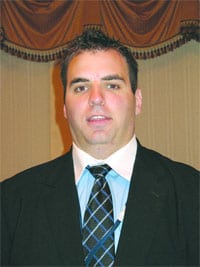Seeing the Light Cutting-edge Victrectomy Slows Visual Deterioration without Sutures
For many people with diabetes, the thought of vision loss, among the many potentially devastating complications of the disease, is terrifying. But unfortunately, diabetic retinopathy is still one of the leading causes of severe vision loss in the U.S.
With strict control of serum glucose levels, and appropriate screening for the early signs of diabetic retinopathy with periodic eye examinations, many patients with diabetes can lower their risk of serious visual loss. In some cases, however, long-standing diabetes can still result in vision-threatening retinopathy. Laser photocoagulation and vitrectomy surgery are two surgical treatments that can slow visual deterioration or even improve visual function.
Now, eye surgeons at Baystate Medical Center are performing a new, sutureless form of the vitrectomy procedure using instruments as small as the tip of a pencil, and offering patients a less-invasive means of aiding their vision and quickening their recovery time.
Although patients with diabetes can also suffer from other eye conditions such as cataracts or glaucoma, it is the damage to the retina that poses the largest threat. After years of diabetes, damage to the retinal blood vessels can result in edema, ischemia, and hemorrhage. Edema of the central retina — the macula — can lead to moderate, gradual vision loss.
Laser photocoagulation can help to decrease the leakage from damaged blood vessels and improve the edema. In other cases, retinal ischemia triggers abnormal blood vessels to form on the retinal surface. These new vessels, called neovascularization, can rupture and lead to sudden and severe vision loss.
While laser photocoagulation again can be effective in the treatment of these neovascular vessels, called proliferative retinopathy, once a significant hemorrhage occurs, laser treatments alone may not be possible.
According to Dr. Bradley Foster, an eye surgeon with New England Retina Consultants in West Springfield who is on staff at Baystate Medical Center, “laser treatments are performed in an office setting whereby the laser light is directed through a dilated pupil at the retinal surface. However, when a vitreous hemorrhage, or severe bleed within the eye, is present, laser light is blocked from reaching the desired tissue.
“It’s a catch-22,” he continued. “They need laser treatment to stop the bleeding, but the laser will not penetrate all the blood. The vitreous hemorrhage therefore needs to be evacuated before adequate laser treatment can be applied.”
Vitrectomy surgery was pioneered in the early 1980s. During this procedure, the jelly-like vitreous fluid that fills the eye can be safely removed. It has proved to be invaluable in the treatment of many retinal disorders, including diabetic retinopathy and retinal detachments, as well as less common problems, such as macular holes, epiretinal membranes, or certain complications after cataract surgery.
Conventional vitrectomy surgery, an outpatient procedure, is performed through three 20-gauge openings. A fiber-optic light is used for illumination, and an infusion cannula helps maintain the intraocular pressure and replaces fluid that is removed. The vitrector itself is a device that allows for simultaneous aspiration and cutting of the vitreous gel. In a case of a vitreous hemorrhage, the blood, which collects within the vitreous cavity, is also evacuated.
For many years, said Foster, performing vitrectomy with 20-gauge instruments was the standard of care. “It works well,” he said, “but the three surgical openings must each be sutured closed. Surgical time is longer, post-operative discomfort is greater, and healing is slower than with some newer techniques.”
For 55-year-old John Vachula, nearly three decades of diabetes has taken a toll on his eyes. He has suffered from diabetic retinopathy and has required numerous laser treatments. But Vachula’s retinopathy was quite aggressive, and he developed a large vitreous hemorrhage.
“Mr. Vachula has had multiple laser treatments, which were effective for controlling his proliferative diabetic retinopathy for several years,” said Foster.
Ultimately, however, he suffered a vitreous hemorrhage with severe visual loss.”
About a year ago, Vachula became one of the first of Foster’s patients to undergo the new sutureless vitrectomy procedure. “I went in early in the morning for the procedure,” Vachula said, “and I was on my way home by 10:30 a.m. that same morning. I had no pain at all, and about two weeks after the surgery, I had my vision back.”
While he also suffers from other eye problems, such as cataracts and glaucoma, Vachula said he has had no further bleeding in the eye on which Foster operated, and his vision has been maintained. Foster has been monitoring his other eye, which has had several smaller bleeds, but if it were to progress, Vachula said he “would love to have the same procedure for my other eye.”
Recently, Foster and his colleague, Dr. David Agahigian, began using smaller, 25-gauge instruments to perform vitrectomy procedures. “Twenty-five gauge vitrectomy is a recent advancement,” Foster said. “The instrumentation is small enough that the entry sites are self-sealing and no sutures are required. We can perform these procedures faster, and patients experience less post-operative discomfort with quicker visual rehabilitation.”
“The advantages of the 25-gauge procedure,” said Patricia McKenna, RN, service lead for Plastics and Ophthalmology at Baystate, “is that it is minimally invasive surgery and no sutures are required to close the sclera or conjunctiva at the end of the case. This results in less pain, fewer complications, and decreased surgery time.”
Foster said that while vitrectomy with 25-gauge instruments is becoming more common, not all patients are candidates. The instruments are fairly flexible, and for patients that will require more extensive manipulation, 20-guage instruments may still be superior.
Currently, Baystate Medical Center is the only site in Western Mass. offering 25-gauge vitrectomy, and Foster and Agahigian have performed more than 100 cases in the last six months.


Comments are closed.